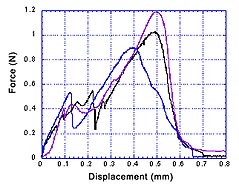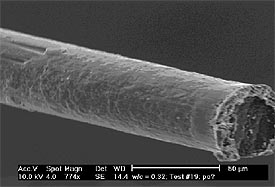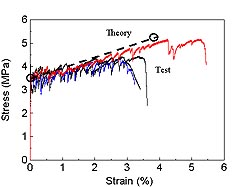by Cynthia Wu
1 Introduction
In the civil engineering community, the need to build safer structures, designed in accordance with performance and cost requirements, is a perpetual goal. For fiber reinforced composites as the selected construction material, performance and cost can often lead to conflicting goals. High performance fibers are often accompanied with high cost. With the introduction of the lower cost, high performance PVA fiber on the construction market, a possible new avenue is presented where both requirements can be satisfied. However, the recent developments of the high performance PVA fiber have not been completely successful in translating its microscopic properties to high performance composite property, specifically tensile strain capacity (e.g. mechanical property required in damage-tolerant structures).
In light of this, the research work attempted to design a PVA-ECC by utilizing the Performance Driven Design Approach (PDDA) in unifying the relationships between the microscopic properties to the necessary composite properties needed to reflect actual structural performance. Guided by this approach, the foundation of this work was provided by micromechanical models that predicted the pseudo strain-hardening capacity with input material properties, fiber, matrix and interface. By using the model to designate the material properties that would satisfy the performance requirements of a ductile composite (e.g. strain capacity exceeding 4%), the PVA-ECC was designed. An experimental program was designed to measure the microscopic properties, namely the interfacial bond properties. In addition, to validate the modeling predictions of pseudo strain-hardening (PSH) behavior, an experimental program of tensile tests was carried out. It was shown that with the guidance of the micromechanical models, the translation from microscopic to macroscopic property was successful. In the following sections, an overview of the research is presented, along with the overall conclusion, and recommendations for further study.
2 Summary and Conclusions
With the dissertation organized in relation to the PDDA, the development of the work proceeded accordingly, beginning with Chapter 1 reviewing the aim and scope of the current research study. This research work is based on the concept that by exploiting the link between the material microstructure and macroscopic composite property through micromechanical modeling, the resulting material should be cost-efficient, while satisfying the dictated structural performance requirements. The following is a succinct list of the significant conclusions and its role in the overall scheme of research conducted.
(1) Development of Micromechanics-based Tailoring Design Scheme
A number of combinations of the fiber, matrix, and interface could potentially satisfy the desired composite property, at least theoretically. One of the main research tasks, thus, was to select a finite range of fiber, matrix and interfacial properties, knowing that these properties are indeed inter-related. Hence, a systematic design scheme to choose these parameters became necessary.
The micromechanical-based tailoring design scheme was developed in Chapter 2, where the strain-hardening model was predominantly used. In determining the proper range of the material microstructure (e.g. fiber, matrix and interface), a feasibility study was conducted which revealed several modeling insights that govern PSH behavior. These insights included high fiber strength and fiber elongation, low chemical bond and apparent strength reduction factor f’, and low matrix toughness. From this stage, a set of three constraints as defined by fiber manufacturability, economy and shrinkage control was found necessary to narrow this range of micro-parameters. As a result of the micromechanical modeling and utilizing the three constraints, Fibers A’ and B’ with lengths of 12 mm, were the final selections. The emphasis was on high fiber strength (Fiber B’, nominal fiber strength: 1620 MPa) and high fiber elongation (Fiber A’, elongation: 7.4%), as indicated by the modeling insights. Since low matrix toughness is critical in attaining PSH behavior, and in regard to the shrinkage control constraint, high amounts of fine sand (50-150 mm) were used. To provide a guideline for the subsequent experimental single fiber pullout tests, the micromechanical models produced a range of frictional bond and chemical bond properties.
This research demonstrated that micromechanics can be combined with practical constraints to tailor material constituents for targeted composite properties.
(2) Influence of Oiling Agent on Bond Properties
As a progression of the micromechanical modeling conducted earlier, in Chapter 3, the focus shifts to the measurement of the microscopic interfacial bond properties to achieve the composite property as designated. With the fibers selected in Chapter 2 (e.g. Fibers A’ and B’), an investigation of the influence of surface treatment on the bond properties is conducted to achieve the frictional bond range as designated by the micromechanical model. It was found that the oiling agent is effective in reducing both the frictional and chemical bond. Even with the oiling agent surface treatment, fiber delamination was still present, as observed in SEM pictures. However, with increasing oiling agent content, with reduction in the frictional bond, the measured slip-hardening parameter b was found to decrease. It was concluded that reduced frictional slippage between fiber and matrix from the oiling agent resulted in lessened fiber delamination. Another insight drawn from these single fiber pullout tests was the effect of delamination of the pullout curve. Following peak pullout load, the fiber underwent a reduced slip-hardening portion as compared to a full slip-hardening pullout curve. This is attributed to the reduced fiber diameter, which resulted in a reduced effective frictional bond, leading to sudden slippage, as opposed to more gradual slippage.
A significant linkage was made between the targeted bond properties from the use of micromechanics, the actual achievement of these bond properties in practice through the use of the oiling agent, and the resulting ductile composite behavior, as was predicted by the strain-hardening model. This linkage was exemplified with the heavily oiled Fiber B’ (0.8%) composite.
(3) PVA-ECC Composite with High Strain Capacity
The effect of fiber, surface treatment, and matrix composition (e.g. fine sand) on tensile properties was investigated in Chapter 5, with the experimental program of tensile tests. Material variation was found to be prevalent in the tensile performance, where the cracking pattern often varied within the same set of tests specimens (e.g. same fiber, oiling content, and sand content). However, it was found that the composite with the heavily oiled fibers (0.8%) showed increased robustness, primarily due to decreased fiber rupture, as confirmed by SEM pictographs. In addition, it produced the highest strain capacity (exceeding 4% strain) as compared to the less oiled fiber composites (lower than 3% on average), as predicted by the micromechanical model. This high strain capacity of the 0.8% oiled Fiber B’ composite was achieved with an optimal sand content, where it was found that the sand content not only influences the matrix toughness, but also the frictional bond. For each quantity of oiled Fiber B’ composite, there was an optimal sand content, where with decreasing oiling, the optimal sand content also decreased, indicating the sand content scaled with the frictional bond. Thus, another advantage of a higher oiled composite is the opportunity for the sand content to be increased, which in turn can lower costs.
The composite tests provided experimental verification of the micromechanical modeling predictions where with proper fiber, matrix and interfacial bond properties, a strain-hardening composite (e.g. > 4% strain) can be produced with the 0.8% oiled Fiber B’ composite. In addition, it was found that with increased oiling agent content, the cmc (minimum flaw size activating cracking) decreased, primarily attributed to the reduction of the frictional and chemical bond, resulting in less fiber rupture, hence increasing the bridging stress. In addition, the first crack stress reduces due to the lowered frictional and chemical bond, as shown in the parametric study of the first cracking stress-normalized crack size. Both scenarios result in lower cmc. Indeed, it was experimentally observed that more cracks were activated with the highly oiled (0.8%) Fiber B’ composite.
Thus, the 0.8% oiled Fiber B’ provided evidence of successful translation of tailored microstructure to desired composite property. The PVA-ECC material can now be used commercially in applications requiring high inelastic deformation, such as plastic hinging regions of structural elements located in seismic areas, or pavements overcoming shrinkage and thermal stresses.
3 Specific Conclusions
- Ideal Fiber Properties: From the modeling insights, high fiber elongation and fiber strength were found to be conducive for strain-hardening behavior. For Fiber A, the emphasis was on high fiber elongation, where 12-13% elongation was specified, along with fiber strength of 1500 MPa, fiber diameter of 49 mm, and Young’s modulus of 30 GPa. For Fiber B, the emphasis was on high fiber strength, 1800 MPa. The fiber elongation specified was between 7 and 8%, fiber diameter of 38 mm, and Young’s modulus of 35 GPa.
- Ideal Corresponding Bond Properties: For both fibers, the chemical bond needs to be minimized below 2 J/m2. For Fiber A’, the frictional bond range should be between approximately 1 and 4.5 MPa. For Fiber B’, the range should be between 1 and 2 MPa. The range is more constrained for Fiber B’ due to increased tendency for fiber rupture.
- Strain Capacity of tailored PVA-ECC increased five-fold from previous PVA-FRC behavior: Previous PVA fiber composites behavior exhibited strain levels below 1%. However, with the micromechanics-based tailoring, the tensile strain capacity of the PVA-ECC exceeded 4%.
4 Recommendations for Future Research
To continue the research studies presented, the following topics for future study are presented.
- Design fiber microstructure to reduce delamination: It was shown that fiber abrasion contributes to decreased bridging performance from lowered apparent fiber strength, where the specified fiber nominal strength is not the true fiber strength. Fiber delamination also results in material inconsistency due to increased fiber rupture or decreased fiber diameter, influencing the frictional bond. It is recommended that for the manufacturers of PVA fibers should produce fibers with increased lateral resistance, thereby reducing delamination.
- Model reduced slip-hardening after peak pullout load and include fiber rupture due to slip-hardening: As mentioned above, the role of fiber abrasion contributes to a decreased slip-hardening effect after the peak pullout load is reached. Conversely, the fiber can also rupture due to severe slip-hardening process during the fiber pullout. Both scenarios need to be included in the numerical micromechanical model that predicts the composite bridging relation.
- Establish relationship between oiling agent quantity and snubbing: In the current study, the effect of sand content on the snubbing behavior was presented. Since surface treatment was found to be highly effective in altering the bond properties, the role of the oiling agent should also influence the snubbing behavior, as well. The extent of this influence needs to be quantified.
- Quantify effect of fine sand on matrix toughness: Experimental tests to measure the matrix toughness Km must be conducted to confirm the hypothesis of decreased matrix toughness with increased fine sand content (up to a certain amount).
- Test durability of PVA-ECC: When the PVA-ECC material is used as part of the structural framework of a building, the material is subjected to various weather conditions, in addition to age deterioration. Tests should be conducted to examine the material’s weatherability and resistance to age deterioration on its material properties.




